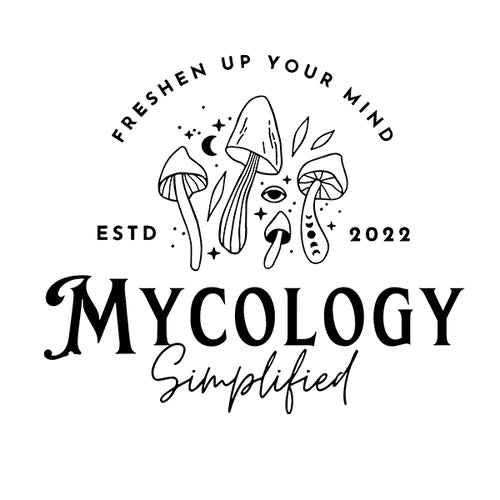
How to Make CVG Substrate Using the Bucket Tek Method
Compartir
How to Make CVG Substrate Using the Bucket Tek Method
If you're looking to create a high-quality substrate for your mushroom cultivation, CVG (Coco Coir, Vermiculite, and Gypsum) is a popular choice. The Bucket Tek method offers a simple, efficient way to prepare CVG without the need for complicated equipment. In this post, we'll walk you through the steps to prepare CVG using the Bucket Tek, ensuring that your mushrooms have the perfect environment to thrive.
What is CVG Substrate?
CVG stands for Coco Coir, Vermiculite, and Gypsum. This combination creates an ideal substrate for many types of mushrooms, offering excellent moisture retention, proper air exchange, and nutrients for healthy mycelial growth. It’s especially popular in the cultivation of species like Psilocybe cubensis.
Why Use the Bucket Tek?
The Bucket Tek method is a simple yet effective way to hydrate and mix your CVG ingredients. By using a 5-gallon bucket, this method ensures an even consistency while requiring minimal effort. It’s ideal for beginners and experienced growers alike, as it reduces the mess and hassle of traditional hydration methods.
What You’ll Need:
- Coco Coir: 1 brick (typically 650g) or 2.5-3 liters of loose coir
- Vermiculite: 1.5 to 2 quarts (1.5L) for proper moisture retention and aeration
- Gypsum: 2 tablespoons (around 30g) for pH buffering and added minerals
- 5-Gallon Bucket: For mixing and hydrating the substrate
- Water: 4-5 quarts (3.8-4.7L) of hot, non-chlorinated water for hydration
- Strainer: Optional, for draining excess water if necessary
- Blanket: For wrapping the bucket during pasteurization
Step-by-Step Instructions:
1. Hydrate the Coco Coir
Start by breaking your coir brick into smaller pieces and place them in the 5-gallon bucket. Slowly add 4-5 quarts (3.8-4.7L) of hot water, heated to around 180°F (82°C), to the coir. Stir as it hydrates, breaking apart any remaining chunks. The water should be enough to fully hydrate the coir, but it shouldn't be soaking wet. Aim for a consistency where the coir is moist but not dripping.

2. Add Vermiculite
Once the coir is fully hydrated, add about 1.5 to 2 quarts (1.5L) of vermiculite. This helps to improve aeration and moisture retention. Mix thoroughly to ensure an even distribution of the vermiculite throughout the coir.
3. Add Gypsum
Next, add 2 tablespoons (around 30g) of gypsum to the mixture. Gypsum helps to buffer the pH of the substrate, making it more favorable for mycelial growth. It also provides important minerals like calcium and sulfur, which mushrooms need for healthy growth.
4. Mix Thoroughly
Once all the ingredients are in the bucket, stir everything together thoroughly. Use your hands or a clean tool to ensure an even consistency. The substrate should feel moist but not wet, and there should be no dry clumps. If it feels too wet, add a little more vermiculite or coco coir until the consistency is right.
5. Pasteurize the Substrate
To pasteurize the CVG, cover the bucket with the lid and wrap it in a blanket. The heat from the hot water will pasteurize the substrate, killing off any unwanted microorganisms without sterilizing it completely. Let the bucket sit overnight at room temperature. This allows the pasteurization process to take place while the substrate cools to an optimal temperature for inoculation.
6. Let it Sit and Cool
Once your CVG mixture is thoroughly hydrated, mixed, and pasteurized, leave it wrapped in the blanket to cool to room temperature. This is important because you want to avoid adding spawn to a hot substrate, which could damage the mycelium.

Benefits of the Bucket Tek Method
- Simplicity: No complicated equipment is needed. Just a bucket and a few basic ingredients.
- Consistency: Ensures an even, well-mixed substrate every time.
- Efficiency: You can prepare large batches of CVG with minimal effort and time.
- Cost-Effective: The ingredients are affordable and readily available.
- Built-in Pasteurization: By using the blanket-wrapped bucket method, you can achieve pasteurization in a straightforward and energy-efficient manner.
Common Mistakes to Avoid
- Over-wetting the Coir: If the coir becomes too wet, it can lead to poor mycelial growth. Always aim for a moist but not soaking wet substrate.
- Not Mixing Enough: Make sure the ingredients are mixed evenly to ensure the best growth conditions for your mushrooms.
- Using Chlorinated Water: Chlorine can hinder mycelial growth, so always use non-chlorinated water, preferably filtered or tap water that has sat for 24 hours.
Conclusion
The Bucket Tek method is an easy and efficient way to prepare and pasteurize CVG substrate for your mushroom cultivation. By following the steps above and avoiding common mistakes, you can create an ideal environment for your mushrooms to grow strong and healthy. Happy growing!
